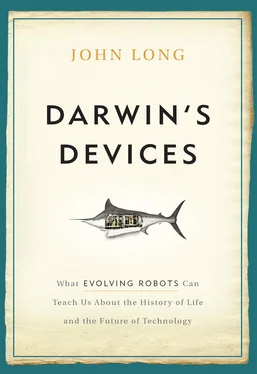The particular microcontroller we used for Tadros 2 to 4 was a HandyBoard, invented by Fred Martin at MIT (see \en.wikipedia.org/wiki/Handyboard for a great picture and a useful overview). The original Tadro1 had a completely analog electronic brain.
The software that runs on the Handyboard, Interactive C, was originally developed for LEGO Robotics competitions. Two versions of Interactive C are available, one by Newton Labs (www.newtonlabs.com/ic/) and the other by the KISS Institute (www.botball.org/ic).
Alva Noë, Action in Perception (Cambridge, MA: MIT Press, 2004).
For a review of the work of Floreano and his colleagues on this topic, see Mototaka Suzuki and Dario Floreano, “Enactive Robot Vision,” Adaptive Behavior 16, nos. 2–3 (2008): 122–128. Enactive perception has also been put to good use in the training of AMAR-III, a humanoid robot that categorizes objects based on its enactive experience with them (http://spectrum.ieee.org/robotics/artificialintelligence/a-robots-body-of-knowledge).
George Lakoff and Mark Johnson, Philosophy in the Flesh: The Embodied Mind and Its Challenge to Western Thought (New York: Basic Books, 1999).
Ecological psychology was created by J. J. Gibson. Here’s a great place to start: J. J. Gibson, “Visually Controlled Locomotion and Visual Orientation in Animals,” British Journal of Psychology 49, no. 3 (1958): 182–194.
Lawrence W. Barsalou, “Grounded Cognition,” Annual Review of Psychology 59 (2008): 617–645.
Once again I refer you to Pfeifer and Scheier’s excellent book, Understanding Intelligence .
Even if you have heard about Phineas Gage before, you should read this fascinating paper: H. Damasio, T. Grabowski, R. Frank, A. M. Galaburda, and A. R. Damasio, “The Return of Phineas Gage: Clues about the Brain from the Skull of a Famous Patient,” Science 264, no. 5162 (1994): 1102–1105.
NOVA, “Musical Minds,” www.pbs.org/wgbh/nova/musicminds/. A video fMRI of Sack’s brain listening to music can be found at www.pbs.org/wgbh/nova/musicminds/extra.html.
J. M. Fuster, “Upper Processing Stages of the Perception-Action Cycle,” Trends in Cognitive Science 8, no. 4 (2004): 143–145.
E. Tytell, C-Y. Hsui, T. L. Williams, A. V. Cohen, and L. Fauci, “Interactions Between Internal Forces, Body Stiffness and Fluid Environment in a Neuromechanical Model of Lamprey Swimming,” Proceedings of the National Academy of Sciences 107, no. 46 (2010): 19832–19837.
Alan Mathison Turing, “Computing Machinery and Intelligence,” Mind 59, no. 236 (1950): 433–460.
Dedre Gentner and B. Bowdle “Metaphor as Structure-Mapping,” in The Cambridge Handbook of Metaphor and Thought , edited by Raymond W. Gibbs Jr., 109–128 (New York: Cambridge University Press, 2008).
David Kelley, The Art of Reasoning, 3rd ed. (New York: W. W. Norton & Company, 1998).
A good introduction to functionalism and other issues in the philosophy of mind can be found in K. T. Maslin, An Introduction to the Philosophy of Mind, 2nd ed. (Malden, MA: Polity Press, 2007).
Many different flavors of functionalism exist. “Artificial Intelligence” functionalism, for example, attends to the creation of the same kind of intelligence in vertebrates, computers, and robots. I think you can also make a case for what I call Biological Functionalism: when independent evolutionary events converge on similar functional designs. For example, the brains of birds and mammals are very different in terms of how the different parts have evolved compared to their hypothetical common ancestor. But some birds, like crows and parrots, manage to have brains that allow them to make and use tools and language. These convergent abilities show that some birds and mammals possess the same kind of intelligence (= similar function) that is created by different structures. For a great review of the functional similarities and structural differences of birds and mammals, I recommend the following paper: Ann B. Butler and Rodney M. J. Cotterill, “Mammalian and Avian Neuroanatomy and the Question of Consciousness in Birds” Biological Bulletin 211, no. 2 (2006): 106–127.
Robert M. Pirsig, Zen and the Art of Motorcycle Maintenance: An Inquiry into Values (New York: William Morrow, 1974).
Yes, this is the same conceptual cat that Norbert Weiner used, as we spoke of in Chapter 1, to assert problems with modeling: the best model of a cat is a cat. Interesting, is it not, that Weiner’s cat surfaces here as a warning about studying the cat itself? The cat has Weiner’s tongue.
Robert C. Brusca and Gary J. Brusca, Invertebrates, 2nd ed. (Sunderland, MA: Sinauer Associates, 2003).
Georg F. Striedter, Principles of Brain Evolution (Sunderland, MA: Sinauer Associates, 2005).
Howard Gardner, Intelligence Reframed: Multiple Intelligences for the 21st Century (New York: Basic Books, 1999).
This is why, by the way, we do spend time on neuroscience in Introduction to Cognitive Science (Cogs 100)! We also spend time on philosophy because of the important attempts to rationally define and understand what in the world we are trying to talk about when we use words and concepts such as mind, brain, behavior, and intelligence.
A great place to start is with this book: Patricia Churchland, Brain-Wise: Studies in Neurophilosophy (Cambridge, MA: MIT Press, 2002).
If you care about building intelligent machines, you must read this book: Jeff Hawkins and Sandra Blakeslee, On Intelligence: How a New Understanding of the Brain Will Lead to the Creation of Truly Intelligent Machines (New York: Times Books, 2004).
Steven Vogel and Stephen A. Wainwright, A Functional Bestiary: Laboratory Studies about Living Systems. (Reading, MA: Addison-Wesley, 1969), 93.
Descartes is often considered to be the father of cognitive science because he approached the mind-body problem rationally and scientifically. Even though substance dualism was quickly, even in his day, refuted as a scientific theory, we talk about it in cognitive science because it underwrites so much of our intuition about minds, souls, ghosts, and heaven. For an introduction to dualism, visit the Stanford Encyclopedia of Philosophy: \plato.stanford.edu/entries/dualism/#SubDua, or read chapters 1 and 2 in Maslin, An Introduction to the Philosophy of Mind .
This paper does a great job explaining neural circuits and their functions: D. W. Tank, “What Details of Neural Circuits Matter?” Seminars in the Neurosciences 1 (1989): 67–79.
Talk here of circuits and what’s necessary and sufficient to show causal relations of neural circuits to behavior are largely drawn from his book, which I strongly recommend: Thomas J. Carew, Behavioral Neurobiology: The Cellular Organization of Natural Behavior (Sunderland, MA: Sinaur and Associates, 2000).
Читать дальше












